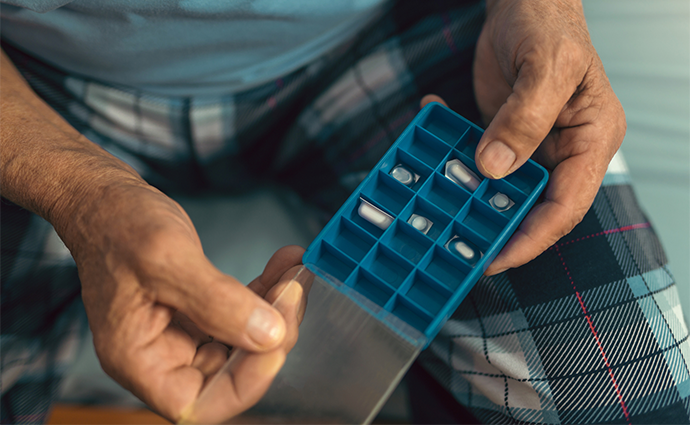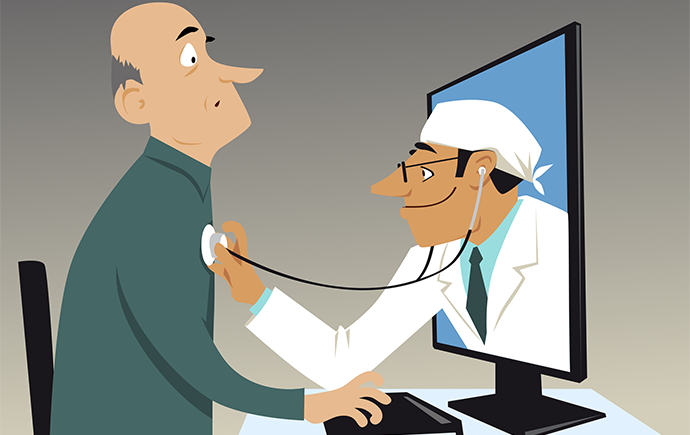Using Telehealth, mHealth Technology to Help Seniors Age in Place
From mHealth apps to telehealth platforms to sensor-embedded smart homes, connected care technology is helping America's growing ranks of seniors stay healthy and active.
From innovative connected care platforms to the Internet of Things, telehealth is showing today’s seniors (and tomorrow’s soon-to-be seniors) how they can live out their golden years in their own homes.
The projected surge in Baby Boomer seniors, combined with an overtaxed healthcare system running short on doctors and nurses, is helping to put the focus on telehealth and mHealth solutions that improve care coordination and management.
"The way that people age is changing," Jo Ann Jenkins, chief executive officer of the AARP, said at a 2016 connected health conference hosted by the Healthcare Information and Management Systems Society (HIMSS).
They’re not only living longer, she said, but being more active and health conscious – "living in different ways" that require new approaches to health management.
These new approaches include mobile health devices and telehealth platforms designed specifically for the senior who is “aging in place,” as well as telemedicine programs designed to improve social and clinical outcomes at senior living facilities and long-term care facilities.
Jenkins’ words are borne out by two statistics reported by AARP: the number of seniors requiring additional caregiving and support due to chronic disease will increase from about 14 percent of the senior population in 2010 to 21 percent by 2050, putting the pressure on healthcare providers to improve caregiving platforms.
On the other hand, 87 percent of seniors age 65 and older, and 71 percent of those between 50 and 64, want to age in place, and will require home-based technology to make that a reality.
Dig Deeper:
Telemedicine Robots: Out of Science Fiction and Into the Mainstream
mHealth and Housing: A Vital Recipe for Senior Health

FROM PERS TO PERSONAL HEALTH ASSISTANTS
Technology has long been used to assist seniors with everyday activities, from easy-to-use tablets, laptops and remote control devices (often with larger buttons and quick links to favorite sites and communication tools) to the personal emergency response service (PERS) tool – the “I’ve fallen and I can’t get up” pendant or wristband.
But recognizing that health and wellness play an increasingly important role in a senior’s daily activities, mHealth and telehealth entrepreneurs and health systems have begun to develop platforms that integrate senior services with healthcare.
Now the senior-friendly laptop includes a quick link to one’s care team, be it the primary care doctor, home health aide or the next-door neighbor who helps with the daily medications. Other apps invite seniors to exercise, play games to strengthen their mental acuity or stay abreast of the latest health and nutrition news.
With the advent of mHealth sensors, wearables, PERS pendants, clothing and accessories like belts and shoes have been turned into medical monitors, helping seniors to monitor their vital signs and daily activity and send that information to the care team.
Some of the more senior-friendly telehealth and mHealth technologies include:
Personal home assistants – Smart devices like Amazon Alexa and Google Home are being used by seniors – and by senior living facilities - to remind them of their daily plans, including when to take medications, exercise, visit the doctor or take blood pressure or blood glucose readings. They can also summon help (the in-home equivalent of the PERS device) or answer simple health and wellness questions.
Smart medication containers – Smart pillboxes and similar in-home mHealth devices are being designed to remind the senior when to take prescriptions, along with what medications to take and him much. Some of these devices alert the senior by flashing lights or making a specific sound, or they can call out or send a message to the senior’s smartphone or tablet. They also measure adherence, recording when and how much medications are taken, sometimes using video to make sure the senior is taking the drug.
Sensor-embedded clothing – Clothes, belts, socks and shoes are being embedded with sensors to measure how a senior moves around, often with the goal of detecting an unsteady gait, evidence of a loss of balance and preventing falls, or alerting the care team when a fall happens. Other pieces of clothing are fitted with sensors to detect changes in body temperature, heart rate, even irregular movements that could indicate confusion.
The smart home – Thanks to the Internet of Things, a senior’s apartment of home can feature a wide variety of mHealth helpers. These include motion detectors that can track a senior’s activity through the house, including trips outdoors, bathroom visits and meals (measured by opened refrigerator doors, use of the stove or microwave, etc.); connected weight scales; sensor-embedded mattresses that measure sleep and even some vital signs; televisions that include online links to the care team; even personal robots that manage medications, deliver reminders and provide companionship.
While the amount of innovation shows no signs of slowing down, experts expect the connected care platforms of the future to become more intuitive. Home-based platforms will not only relay data back to caregivers, but put that data into the medical record.
Artificial intelligence software will analyze that data and predict a senior’s health emergency or fall before it happens. And a senior released from the hospital will come home to find personalized health and wellness tips, prescription instructions and post-discharge care plans loaded onto the smart TV and/or tablet.
mHealth’s Missing Link: Technology That Helps the Caregiver
Telehealth Will Only Benefit Seniors if They Know It’s Available

IMPROVING SENIOR TELEHEALTH PROGRAMS THROUGH POLICY
As with most connected care programs, healthcare providers will embrace and adopt senior telehealth services if they’re paid to offer those services. For that to happen, the Centers for Medicare and Medicaid Services (CMS) needs to loosen both its restrictions on where telehealth and telemedicine programs can be run and how they’re reimbursed.
On the policy front, CMS and American Medical Association are both looking to expand reimbursement for remote patient monitoring programs through new CPT codes.
“The AMA recommends a measured approach to expand coverage of telehealth and remote patient monitoring services in the Medicare program,” AMA CEO and Executive Vice President James L. Madara wrote to CMS Administrator Seema Verma.
“The AMA strongly supports CMS’ proposal to provide telehealth coverage to seven new codes and urges CMS to expand coverage to unbundled remote monitoring services. In addition, the AMA outlines areas where increased coverage will allow physician practices, health systems, and other healthcare providers to diagnose and treat earlier manifestations of disease in less costly care settings.”
CMS is also facing pressure from Congress to relax its restrictions on telemedicine and telehealth services, paving the way for more home-based services.
Among the many organizations lobbying CMS is HIMSS
“HIMSS encourages CMS to embrace a reimbursement system that recognizes the unique characteristics of connected health that enhances the care experience for the patient, providers and caregivers,” then-HIMSS President and CEO H. Stephen Lieber and Denise W. Hines, chair of the HIMSS North America Board of Directors and CEO of the eHealth Services Group, wrote in a 2017 letter.
Should CMS loosen its telehealth and telemedicine restrictions, either through CPT codes or new programs that allow for virtual care at home, expect more health systems to create platforms of care that address senior health and wellness.
Dig Deeper:
mHealth, Telehealth Providers Target Growing Senior Care Market
Making Telehealth a Valuable Part of Preventive Care Programs

TELEHEALTH AND SENIOR LIVING FACILITIES
Of course, not every senior will be able to live out his or her life at home. And the growing number of elderly Americans needing assistance is putting a strain on retirement communities, senior living centers, skilled nursing facilities and long-term care centers.
They, too, can benefit from telehealth and mHealth.
Many of these facilities have their own nursing and caretaker staff and protocols for summoning emergency healthcare assistance – usually a phone call to the nearest hospital. But with telehealth and telemedicine platforms that include mobile carts, audio-video links and connected devices, a facility can connect with a doctor or specialist at a moment’s notice for an emergency, often eliminating the need for an EMT visit or transport to the hospital.
“Studies show that approximately 60 to 70 percent of all nursing home transfers to the hospital are unnecessary,” says John Whitman, executive director of the Pennsylvania-based TRECS (Targeting Revolutionary Elder Care Solutions) Institute. “Sending a vulnerable senior to the hospital only increases their exposure to a wide range of other proven, adverse effects.”
These virtual connections can also be used for more common and less acute care, such as treatment of a common cold or health concern that might otherwise call for a scheduled trip to the doctor’s office, chronic care management in between regular checkups, and consults with specialists like mental health counselors. It can even be used to connect senior communities with physical therapists for individual and group exercise and rehabilitation programs.
TRECS Institute officials said a 2015 study found that an off-hours telemedicine service averted 91 hospital admissions or readmissions over the course of a year at the Cobble Hill Health Center, a 360-bed SNF in New York, saving the SNF more than $1.3 million in Medicare costs and improving clinical outcomes for the patients.
“Telehealth can enable SNFs to achieve cost efficiencies by building confidence within the skilled nursing care team to proactively and effectively prevent negative health outcomes in clinical scenarios that may otherwise lead to costly, preventable, and sub-standard care,” the study noted.
“These workforce, care management, and clinical benefits can also translate into cost savings by enabling specialists to facilitate much-needed care remotely and improving the capacity of skilled nursing staff to provide quality care on-site which may lead to reductions in unnecessary transfers between care sites and preventable hospital (re)admissions.”
Dig Deeper:
Telehealth Gives Senior Centers a Gateway to Patient Engagement
Survey Shows Senior Homes Aren’t Taking Telehealth Seriously
DESIGNING THE TELEHEALTH-FRIENDLY SENIOR HOME
Going forward, healthcare providers should take steps to ensure their telehealth and telemedicine services address the specific needs of seniors aging in place.
Some helpful tips:
- Make sure the technology is easy to use. Make sure the instructions are simple, the technology is intuitive and the visuals are large. On smartphones, laptops and tablets, the app has to be easy to access and activate, requiring as few steps as possible.
- Include the caregiver. Expect that the app or telehealth service will be used not only by the senior, but by his or her caregivers. In any communications platforms, make the caregiver team – family, friends, neighbors – part of the care management and coordination conversation.
- Include emergency contacts. Any home monitoring platform should be able to access healthcare at a moment’s notice, in case of emergency.
- Don’t overestimate mobility. Design telehealth programs that anticipate mobility problems, so that seniors aren’t rushed or over-extended. With anything that involves exercise or strenuous activity, start slow and allow the senior to adjust.
- Include as much interaction as possible. Many seniors aging at home deal with loneliness and isolation. Create telehealth and mHealth services that allow them to communicate with people – family members, friends,, neighbors, nurses – whenever they want.
- Factor in frequent touches. In any telehealth programs that monitor senior activity, be sure to establish a baseline for normal or daily activity, then configure alerts for when that activity passes above or below that threshold. For instance, check on a senior who isn’t moving around the house or apartment as often as normal, or who is using the bathroom or kitchen either more or less frequently.
The ultimate goal of a connected care platform for seniors, advocates say, is to create an environment at home that enables the senior to live comfortably and safely.





